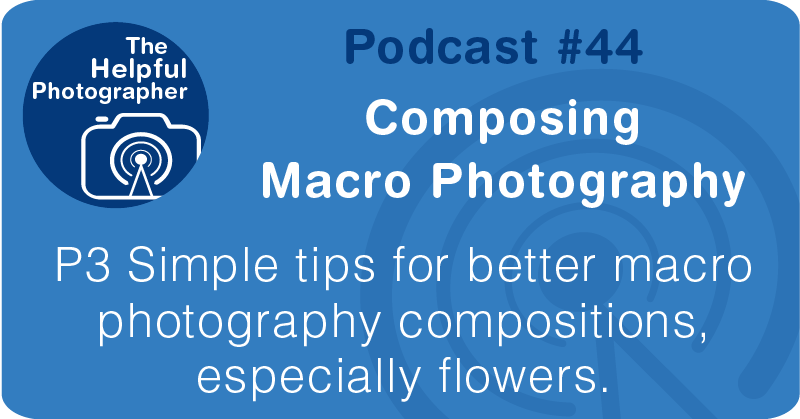Composing Macro Photography #44
Photo Tips Podcast: Composing Macro Photography #44

iTunes
Google
Spotify
Tune In
Stitcher
RSS
Pandora
Photo Tips Podcast: Composing Macro Photography #44
This is the third of a three part series on macro photography.
In the previous two sessions I talked about some of the more technical aspects of macro photography, but as always, it’s not about the camera or any of the equipment or even f/stops and shutter speeds but the composition. Due to the specialized nature of macro photography, you do have to have some special equipment and you will need to have a bit of technical knowledge and I covered that in the first two podcasts, but even if you do have a handle on the technical stuff but don’t think about composition, because if you don’t? You still won’t have an image.
Although composition is a difficult subject to teach via a podcast I hope these few tips will help you move the ball a little further down the road. The most common mistake I see when it comes to photographing flowers in particular, is clutter. Photographers are simply not getting close enough and in many ways their photograph is what I call greedy. Rather than concentrating on one flower, they photograph the entire garden. The solution to this problem is really quite easy. Just choose a hero. Yes, choose one flower to be your main subject and let the rest fade into the background. You can do this by literally featuring one flower or you can create separation with shallow depth of field. You can feature one flower by making sure that your angle is such that the background will just become a field of color or just drops out to black or white. Although it’s often helpful to have a contrasting color you can certainly have similar or even the same color if that color is mostly smooth with little to no texture. You could also have a highly textured background if your main subject is rather smooth. The key is often contrast – in this case contrast of texture. But of course smooth on smooth can create some rather amazing minimalist compositions too. You might be wondering how you can drop the background to black or white if you are shooting outside. Well the answer is actually much easier than you think. One way is to simply bring a black or white cloth or even a matt board and put it behind the subject. But an even easier thing to do is to use the environment. If your subject is in the sun, you can choose an angle where the background is in the shade; this way the background will often drop out to black; you might have to drop your exposure by 1 or 2 stops, otherwise your flower may blow out. You can also amplify this by using a longer lens to compress the dark background behind the flower. Conversely you can create a white background by getting on the ground and shooting up the flower into the bright sky. Not only would this produce a white background but also give you a very different point of view from which to create a composition. Another great trick is to grossly over expose your image by 2 or even 3 stops. What this does is that you are going to get a really nice ethereal feeling out of your image. If none of these options are available then choose a flower that is suitably far from the others to insure that the other flowers will drop out of focus. These methods will definitely help you create a hero.
But what if you need to show a field of flowers? The fact is that most of the time even the best gardens can look sparse, if you choose the wrong angle. Mostly if you are shooting down on a bed of flowers it often seems that there are more leaves than flowers. However if you get low and shoot across the bed you will find that it will feel like you have a field of flowers. To that end you don’t need that many flowers to create this feeling. But do remember that even in those instances, you might want to consider finding a hero.
But as always, I do have to say that there are no rules to composition, only guidelines.
A key element of composition is lighting. You may have everything positioned properly but if your lighting is off, you still won’t have a great image. But like composition it’s not something that can be easily explained in a podcast. But I can share a few ideas on how to get that light better. Very often direct sunlight is way too harsh of a light for a beautiful shot. There are a couple of ways around this. The easiest is to throw a shadow over the subject. You can do this with a hand, and if that’s not enough then hold a magazine over it, and if that’s still not enough you can have someone else to cast a shadow for you. Another thing you can do is to soften the light by using a silk. This term is used to describe a diffuser, like a piece of silk or translucent piece of paper over the subject. An easy thing to do is to take a coat hanger and to make a circular or square shape out of it and to put either a translucent cloth or paper over it. The benefit of this is that it changes the harsh direct light into a beautiful soft light for your subject a lot like a shadow but it’s still allowing a lot of light to pass so you won’t lose so much light. The last option is to bring artificial light. These days you can bring a small array of LED’s but like the options I just mentioned something has to hold it up over your subject, that is unless you use a ring light that goes around your lens. You can also use flash in the form of a pop-up flash or a speedlite attached to your hot shoe. But the problem with the last two options is that the light is often harsh and ugly just like direct sunlight. But as with direct sunlight you can diffuse the light by placing something translucent in front of the light. A great way to do this is to adhere a piece of translucent paper to a flexible piece of plastic that is about 8x8 to 12x12 inches. Then cut a hole in it the size of your lens at the bottom of the plastic. You then slip this over your lens. And there it sits between your subject and your flash, effectively diffusing your flash. But before you celebrate, this option and the on lens ring light option are very flat light sources. Because the direction of the light is coming from the front. It can create a very flat dull looking light. This may or may not be desirable, depending on the subject and or the angle at which you are photographing your subject. But don’t forget that the purpose of adding light is to allow you to shoot at a much faster shutter speed, eliminating the potential motion issue.
As you can see, shooting macro can get rather complicated. But I hope I haven’t scared you from getting started. If you are shooting outside start shooting in the shade and then go from there. You’ll probably get good results and won’t need to think about having to add or diffuse light.











